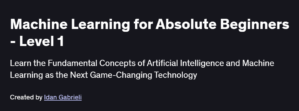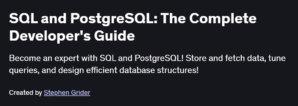What will you in SQL Programming Basics Course
- SQL Fundamentals: Understand the basics of SQL syntax and structure.
- Database Creation: Learn how to create and manage databases.
- Data Retrieval: Use
SELECTstatements to retrieve data from tables.
- Data Filtering and Sorting: Apply
WHEREclauses to filter data andORDER BYto sort results. - Data Aggregation: Utilize aggregate functions like
COUNT(),SUM(),AVG(),MIN(), andMAX(). - Data Grouping: Group data using
GROUP BYand filter groups withHAVING.
Program Overview
Module 1: Introduction to SQL
⏳ 30 minutes
Overview of SQL and its importance in data management.
Setting up the SQL environment.
Module 2: Creating and Managing Databases
⏳ 45 minutes
Creating databases and tables.
Defining data types and constraints.
Modifying and deleting databases and tables.
Module 3: Retrieving Data with SELECT
⏳ 1 hour
Using
SELECTto retrieve data.Filtering results with
WHERE.Sorting results with
ORDER BY.
Module 4: Data Aggregation and Grouping
⏳ 1 hour
Applying aggregate functions.
Grouping data with
GROUP BY.Filtering groups with
HAVING.
Module 5: Modifying Data
⏳ 1 hour
Inserting data into tables.
Updating existing data.
Deleting data from tables.
Module 6: Joining Tables
⏳ 1 hour
Understanding different types of joins:
INNER JOIN,LEFT JOIN,RIGHT JOIN, andFULL JOIN.Combining data from multiple tables.
Module 7: Advanced SQL Topics
⏳ 1 hour
Subqueries and nested queries.
Using
UNIONandINTERSECT.Working with indexes and views.
Get certificate
Job Outlook
High Demand for SQL Skills: SQL is a fundamental skill required in various roles such as Data Analyst, Database Administrator, and Software Developer.
Career Opportunities: Proficiency in SQL opens doors to opportunities in data analysis, business intelligence, and backend development.
Industry Adoption: SQL is widely used across industries including finance, healthcare, and technology for data management and analysis.
Specification: SQL Programming Basics Course
|
FAQs
- No prior programming or SQL experience required.
- Teaches SQL syntax and structure step by step.
- Covers database creation and management.
- Provides hands-on exercises for practical learning.
- Suitable for beginners in data and software roles.
- Retrieve and filter data using
SELECTandWHERE. - Sort and group data with
ORDER BYandGROUP BY. - Use aggregate functions like
COUNT(),SUM(),AVG(). - Join tables using
INNER,LEFT,RIGHT, andFULL JOIN. - Learn subqueries, nested queries, indexes, and views.
- Builds foundational SQL skills for data analysis.
- Prepares for database management and reporting roles.
- Applicable in finance, healthcare, tech, and more.
- Enhances employability in IT and data roles.
- Provides a certificate to demonstrate proficiency.
- Modules include Introduction, Database Management, SELECT queries, Aggregation, Modifying Data, Joins, and Advanced SQL.
- Includes hands-on exercises and examples.
- Self-paced learning allows flexible scheduling.
- Focuses on practical understanding over theory alone.
- Step-by-step approach suitable for beginners.
- Self-paced with lifetime access.
- Average completion time varies per learner, typically a few hours to several days.
- Certificate awarded after finishing the course.
- Certificate can be added to resumes or LinkedIn.
- Allows learners to showcase SQL skills professionally.





